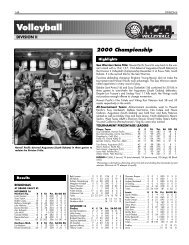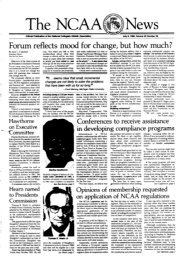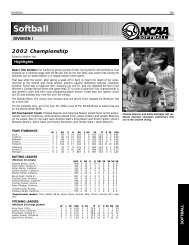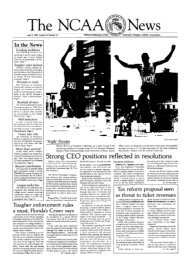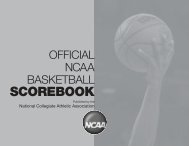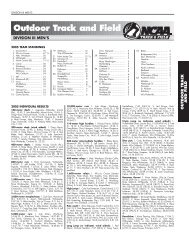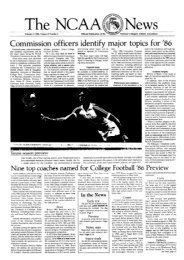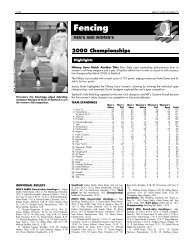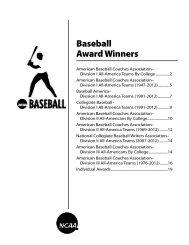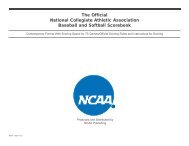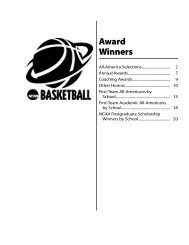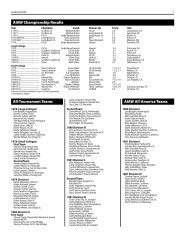Sports Medicine Handbook - NCAA
Sports Medicine Handbook - NCAA
Sports Medicine Handbook - NCAA
You also want an ePaper? Increase the reach of your titles
YUMPU automatically turns print PDFs into web optimized ePapers that Google loves.
92<br />
Protective Equipment<br />
Sport<br />
5. Football<br />
Mandatory Protective<br />
Equipment*<br />
1. Soft knee pads at least ½-inch<br />
thick that are covered by pants. It is<br />
strongly recommended that they<br />
cover the knees. No pads or<br />
protective equipment may be worn<br />
outside the pants.<br />
2. Face masks and helmets with a<br />
secured four- or six-point chin strap.<br />
All players shall wear helmets that<br />
carry a warning label regarding the<br />
risk of injury and a manufacturer’s or<br />
reconditioner’s certification<br />
indicating satisfaction of NOCSAE<br />
test standards.<br />
3. Shoulder pads, hip pads with<br />
tailbone protectors and thigh guards.<br />
4. An intra-oral mouthpiece of any<br />
readily visible color (not white or<br />
transparent) with FDA-approved<br />
base materials (FDCS) that covers all<br />
upper teeth. It is recommended that<br />
the mouthpiece be properly fitted.<br />
Rules Governing Special<br />
Protective Equipment<br />
Illegal equipment includes the<br />
following:<br />
1. Equipment worn by a player,<br />
including artificial limbs, that<br />
would endanger other players.<br />
2. Hard, abrasive or unyielding<br />
substances on the hand, wrist,<br />
forearm or elbow of any player,<br />
unless covered on all exterior sides<br />
and edges with closed-cell, slowrecovery<br />
foam padding no less than<br />
½-inch thick, or an alternate material<br />
of the same minimum thickness and<br />
similar physical properties. Hard or<br />
unyielding substances are permitted,<br />
if covered, only to protect an injury.<br />
Hand and arm protectors (covered<br />
casts or splints) are permitted only to<br />
protect a fracture or dislocation.<br />
3. Thigh guards of any hard<br />
substances, unless all surfaces are<br />
covered with material such as closedcell<br />
vinyl foam that is at least ¼-inch<br />
thick on the outside surface and at<br />
least 3/8-inch thick on the inside<br />
surface and the overlaps of the edges;<br />
shin guards not covered on both sides<br />
and all edges with closed-cell, slowrecovery<br />
foam padding at least ½-inch<br />
thick, or an alternate material of the<br />
same minimum thickness having<br />
similar physical properties; and<br />
therapeutic or preventive knee braces,<br />
unless worn under the pants and<br />
entirely covered from direct external<br />
exposure.



